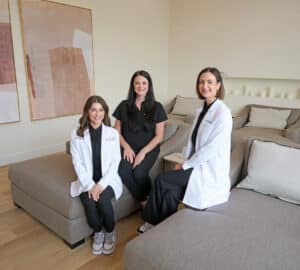There was a time when going under the knife was the only way to turn back the clock of aging. Thanks to advances in technology, however, plastic surgeons now have many options for restoring a youthful glow—and many of them don’t require a large incision or a lengthy recovery period. “The technology is advancing pretty rapidly, and nonsurgical options for rejuvenation are getting better all the time,” says Dr. Marissa Tenenbaum. Board-certified plastic surgeons Tenenbaum and Dr. Terry Myckatyn offer a range of nonsurgical cosmetic procedures at West County Plastic Surgeons of Washington University.
Since 2000, cosmetic surgeries have declined by 12 percent while minimally invasive procedures have skyrocketed 154 percent, according to the American Society of Plastic Surgeons. Tenenbaum says the shift is due to the many benefits of less-invasive approaches, which are more convenient, less painful and sometimes less expensive than traditional alternatives. “It’s also a psychological benefit for people who are afraid of incisions or anesthetics,” she says.
 There are also some problems for which minimally invasive procedures are the best or only option. Cellulite, for example, is not a good candidate for surgery because traditional liposuction (a fat-removal surgery) can actually exaggerate the appearance of lumpy, dimpled flesh. The recently FDA-approved non-surgical CellfinaTM cuts the fibrous bands that create prominent dimples in the skin characteristic of cellulite. “It’s done in the office in about an hour with the patient awake,” Tenenbaum says. “There can be some bruising or swelling, but you can usually see the results right away.” It’s a good alternative to surgery for patients who have tight skin without a lot of fat, she explains.
There are also some problems for which minimally invasive procedures are the best or only option. Cellulite, for example, is not a good candidate for surgery because traditional liposuction (a fat-removal surgery) can actually exaggerate the appearance of lumpy, dimpled flesh. The recently FDA-approved non-surgical CellfinaTM cuts the fibrous bands that create prominent dimples in the skin characteristic of cellulite. “It’s done in the office in about an hour with the patient awake,” Tenenbaum says. “There can be some bruising or swelling, but you can usually see the results right away.” It’s a good alternative to surgery for patients who have tight skin without a lot of fat, she explains.
Like many nonsurgical options, CellfinaTM may be performed in conjunction with traditional surgical methods for optimal results. Patients with sagging skin or excess fat, for example, may benefit from liposuction or a tummy tuck before cellulite treatment. Similarly, non-invasive Ultherapy®, which uses ultrasound to lift and tighten skin, may be used in combination with a neck lift to delay the need for a face-lift.
For treating double chin, there is an in-office injectable, KybellaTM, that can decrease fat in a targeted area under the jaw. Another option is CoolSculpting®, which freezes and destroys fat cells. It’s also popular for reducing fat on the abdomen and inner thighs, Tenenbaum says. Unlike liposuction, which is a surgical fix the results of which can last years, KybellaTM and CoolSculpting® typically require multiple treatments to get desired results. The upside though, notes Tenenbaum, is that both can be done in office with little to no pain or recovery time.
“Patients have more options now than ever before, which makes treatment more tailored to their needs,” Tenenbaum says. “But it’s so important to seek out a board-certified plastic surgeon who understands the full range of options. They can help you decide what is best for you based on your expectations.”
Pictured: Licensed aesthetician Kristi Reasons-Look, Dr. Marissa Tenenbaum, Emily Weinhaus, PA-C, Dr. Terry Myckatyn, licensed aesthetician Kristin Green
Photo courtesy of Washington University
[West County Plastic Surgeons of Washington University, located at 1040 N. Mason Road, Ste. 124, provides cutting-edge surgical and non-surgical procedures. Pictured on the cover: board-certified plastic surgeons Drs. Terry Myckatyn and Marissa Tenenbaum. For more information, call 314.996.8800 or visit westcountyplasticsurgeons.wustl.edu.]








